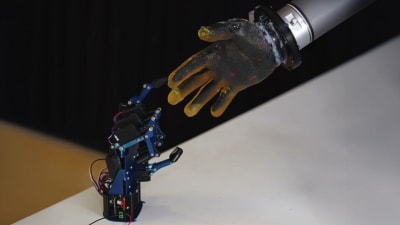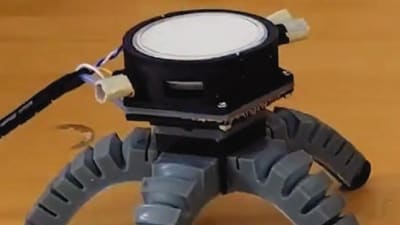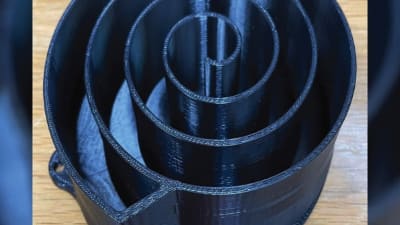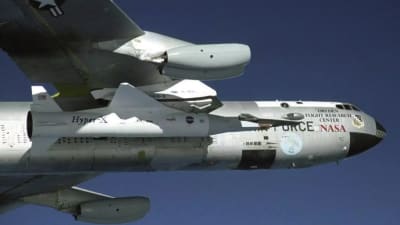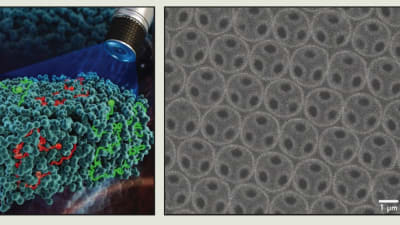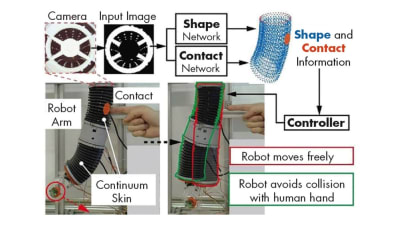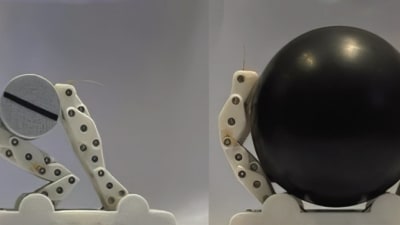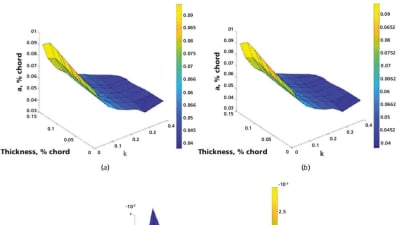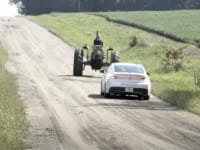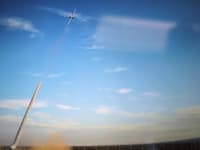39,49,73
61
169
-1
0
30
Briefs: Electronics & Computers
Missions to the moon and other planets will require large-scale infrastructure that would benefit from autonomous assembly by robots without on-site human intervention. NASA Ames Research Center has developed a novel and efficient mobile bipedal robot system to construct low-mass, high precision, and largescale infrastructure. Read on to learn more.
Briefs: Sensors/Data Acquisition
A team of engineers has developed a low-cost, durable, highly-sensitive robotic ‘skin’ that can be added to robotic hands like a glove, enabling robots to detect information about their surroundings in a way that’s similar to humans. Read on to learn more.
Briefs: Manufacturing & Prototyping
NASA researchers are eliminating complex joints by manufacturing a 1-piece TCA utilizing 3D printing and large-scale additive manufacturing technologies to directly deposit the nozzle onto the combustion chamber. And, by replacing a traditional solid metal jacket with a composite overwrap for support, the overall weight is reduced by over 40 percent. Read on to learn more.
Briefs: Mechanical & Fluid Systems
Researchers have created a light-powered soft robot that can carry loads through the air along established tracks, similar to cable cars or aerial trams. The soft robot operates autonomously, can climb slopes at angles of up to 80°, and can carry loads up to 12 times its weight. Read on to learn more.
Briefs: Aerospace
NASA Ames researchers have developed a novel approach for actively controlling Dutch-roll oscillations of an eVTOL aircraft by using existing outboard propellers to dampen oscillations. This novel technology avoids the need to add hardware or change the design of eVTOL vehicles to address the negative effects of turbulence. Read on to learn more.
Briefs: Propulsion
Researchers have developed a compact and versatile robot that can maneuver through tight spaces and transport payloads much heavier than itself. Smaller than a credit card and weighing 6 grams, the nimble swimming robot is ideal for environments with limited space like rice fields, or for performing inspections in waterborne machines. Read on to learn more.
Briefs: Robotics, Automation & Control
It’s a game a lot of us played as children — and maybe even later in life: unspooling measuring tape to see how far it would extend before bending. But to engineers at the University of California San Diego, this game was an inspiration, suggesting that measuring tape could become a great material for a robotic gripper. Read on to learn more about their robot, GRIP-tape.
Briefs: Manufacturing & Prototyping
Researchers at Stanford University have introduced a more efficient processing technique that can print up to 1 million highly detailed and customizable microscale particles a day. Read on to learn more about it.
Briefs: Propulsion
In a recent study published in the journal eLife, an international research group has studied the relationship between electrical stimulation in stick insects’ leg muscles and the resultant torque (the twisting force that makes the leg move). Read on to learn what they found.
Briefs: Robotics, Automation & Control
In creating a pair of new robots, Cornell researchers cultivated an unlikely component: fungal mycelia. By harnessing mycelia’s innate electrical signals, the researchers discovered a new way of controlling “biohybrid” robots that can potentially react to their environment better than their purely synthetic counterparts. Read on to learn more.
Briefs: Materials
A research team led by Associate Professor Tao Sun has made new discoveries that can expand additive manufacturing in aerospace and other industries that rely on strong metal parts. Read on to learn more.
Briefs: Mechanical & Fluid Systems
NASA engineers have developed a new approach to mitigating unwanted motion in floating structures. Ideally suited to applications including offshore wind energy platforms and barges, the innovation uses water ballast as a motion damping fluid.
Briefs: Mechanical & Fluid Systems
Researchers have introduced a microfluidic system that utilizes porous “inverse colloidal crystal” structures to dramatically improve the efficiency of microdroplet generation. Read on to learn more about it.
Briefs: Materials
NASA’s Cryogenic Flux Capacitor capitalizes on the energy storage capacity of liquefied gases. By exploiting a unique attribute of nano-porous materials, aerogel in this case, fluid commodities such as oxygen, hydrogen, methane, etc. can be stored in a molecular surface-adsorbed state. Read on to learn more.
Briefs: Manufacturing & Prototyping
NASA Kennedy Space Center engineers developed a Cryogenic Oxygen Storage Module to store oxygen in solid-state form and deliver it as a gas to an end-use environmental control and/or life support system. Read on to learn more about it.
Briefs: Software
Owl-Wing Study Could Aid in Developing Low-Noise Fluid Machinery
The study could aid in understanding the role of TE fringes in the silent flight of owls and can inspire biomimetic designs that could lead to the development of low-noise fluid machinery. Read on to learn more.
Briefs: Aerospace
University of Virginia researchers showed for the first time that airflow in supersonic combusting jet engines can be controlled by an optical sensor. The finding could lead to more efficient stabilization of hypersonic jet aircraft. Read on to learn more.
Briefs: Power
A novel micropropulsion system was developed for nanosatellite applications using a liquid-fed pulsed-plasma thruster. It uses a liquid propellant for a Lorentz-force pulsed-plasma accelerator and an extended lifetime ignition system driven by nanosecond-long pulses. Read on to learn more.
Briefs: Manned Systems
Over the past year, the DoD has awarded funding to hypersonics research led by University of Central Florida Mechanical and Aerospace Engineering Professor Kareem Ahmed to support the advancements he’s making in the technology. The support is a testament to the progress UCF has made in the field. Read on to learn more about these advances.
Briefs: Unmanned Systems
Applications include vehicle and aircraft tires, sports helmets, military equipment, and seals and couplings. Read on to learn more.
Briefs: Mechanical & Fluid Systems
Inspired by the paper-folding art of origami, North Carolina State University engineers have discovered a way to make a single plastic cubed structure transform into more than 1,000 configurations using only three active motors. The findings could pave the way for shape-shifting artificial systems that can take on multiple functions and even carry a load. Read on to learn more.
Briefs: Propulsion
The “nanoswimmers” could be used to remediate contaminated soil, improve water filtration, or even deliver drugs to targeted areas of the body.
Briefs: Software
The sensing and control principles used in this framework could lead to new tactile sensors that can be attached to any existing robotics system, offering new sensing and control paradigms for safe human-robot interaction without altering the robot’s original design. Read on to learn more.
Briefs: Robotics, Automation & Control
Researchers from NC State University have demonstrated mini soft hydraulic actuators that can be used to control the deformation and motion of soft robots that are less than a millimeter thick. The researchers also demonstrated that this technique works with shape memory materials.
Briefs: Robotics, Automation & Control
Researchers have found a way to bind engineered skin tissue to the complex forms of humanoid robots. This brings with it potential benefits to robotic platforms such as increased mobility, self-healing abilities, embedded sensing capabilities and an increasingly lifelike appearance.
Briefs: Energy
A team of scientists has successfully created a new synthetic metamaterial with 4D capabilities, including the ability to control energy waves on the surface of a solid material. These waves, called mechanical surface waves, are fundamental to how vibrations travel along the surface of solid materials.
Briefs: Mechanical & Fluid Systems
Led by Purdue University, the Resilient ExtraTerrestrial Habitats institute's goal is to “design and operate resilient deep space habitats that can adapt, absorb and rapidly recover from expected and unexpected disruptions.”
Briefs: Aerospace
NASA’s Ames Research Center has developed a novel closed-form solution to model wing flutter aerodynamics for any aircraft wing (within a certain thickness regime and without camber). This closed-form solution can be readily extended to wing sections with camber.
Briefs: Aerospace
A Sustainable Engine with Reduced Assembly Costs
Boom Supersonic, the company building supersonic planes, is developing Symphony, a new propulsion system designed and optimized for its Overture supersonic airliner.
Top Stories
Blog: Manufacturing & Prototyping
2025 Holiday Gift Guide for Engineers: Tech, Tools, and Gadgets
INSIDER: Energy
Scientists Create Superconducting Semiconductor Material
Blog: Software
Blog: Materials
This Paint Can Cool Buildings Without Energy Input
Quiz: Automotive
Blog: Semiconductors & ICs
Webcasts
 Upcoming Webinars: Manufacturing & Prototyping
Upcoming Webinars: Manufacturing & Prototyping
The Real Impact of AR and AI in the Industrial Equipment Industry
 Upcoming Webinars: Motion Control
Upcoming Webinars: Motion Control
Next-Generation Linear and Rotary Stages: When Ultra Precision...
 Upcoming Webinars: Transportation
Upcoming Webinars: Transportation
Hydrogen Engines Are Heating Up for Heavy Duty
 Podcasts: Medical
Podcasts: Medical
How Wearables Are Enhancing Smart Drug Delivery
 Podcasts: Automotive
Podcasts: Automotive
SAE Automotive Podcast: Solid-State Batteries



